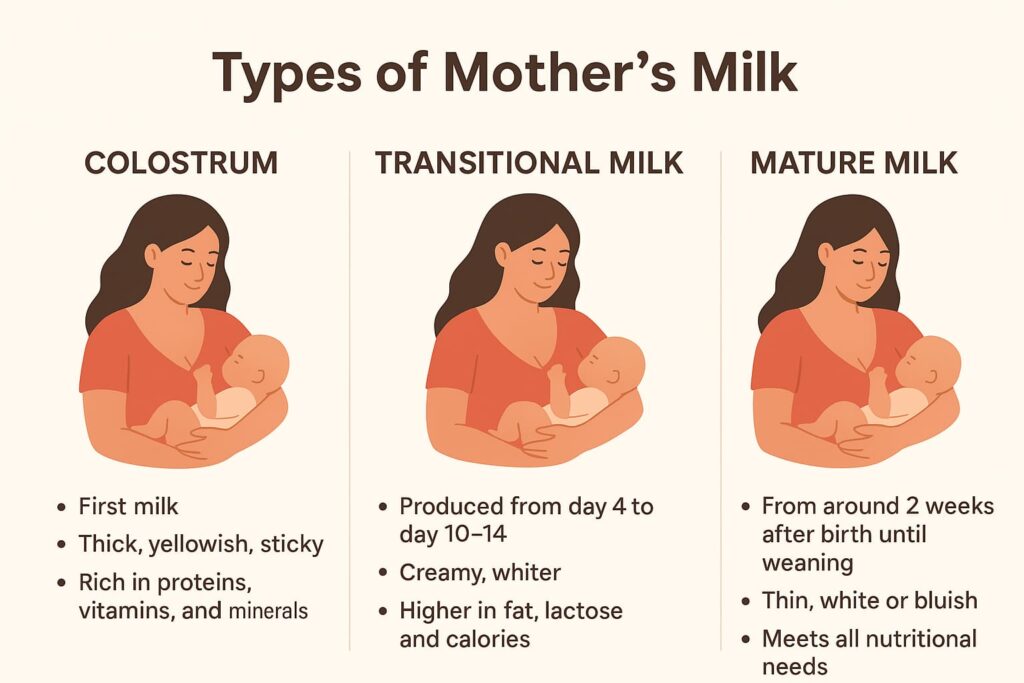Breastfeeding is one of the most natural and important aspects of motherhood. It not only provides complete nutrition to a newborn but also strengthens the bond between mother and child. According to the World Health Organization (WHO), exclusive breastfeeding for the first six months of life is the best way to ensure optimal growth, health, and development of infants.https://ksamdha.com/ Breastfeeding Benefits for Mothers & Baby
What is Breastfeeding?
Breastfeeding, also known as nursing, is the process of feeding a baby with milk directly from the mother’s breast. Mother’s milk is considered the “gold standard” of infant nutrition because it contains the right balance of proteins, fats, vitamins, and antibodies that protect the baby from infections and diseases.
Breast milk adapts according to the baby’s needs:
Breastfeeding Benefits for Mothers & Baby
TYPES OF MOTHER MILK

1- Colostrum (First Milk)
Time of production: From late pregnancy up to 3–5 days after birth.
Appearance: Thick, yellowish, sticky fluid.
Nutrients: Rich in proteins, vitamins (A, E, K), and minerals.
Special Features:
Known as “liquid gold” for newborns.
Contains high amounts of antibodies (especially IgA) that protect the baby from infections.
Acts as a natural laxative, helping the baby pass meconium (first stool).
2 -Transitional Milk
Time of production: From around day 4 to day 10–14 after birth.
Appearance: Creamy, whiter in color compared to colostrum.
Nutrients: Higher in fat, lactose, and calories than colostrum to support rapid growth.
Special Features:
Bridges the gap between colostrum and mature milk.
Helps the baby double birth weight in the first few months.
3 -Mature Milk
Time of production: From around 2 weeks after birth until weaning.
Appearance: Thin, white or bluish in color.
Composition: About 87% water, 7% carbohydrates, 4% fats, and 1% proteins + vitamins, minerals, and antibodies.
Special Features:
Meets all nutritional needs of the baby after the initial weeks.
Contains two parts:
Foremilk: Watery, quenches baby’s thirst.
Hindmilk: Richer in fat and calories, provides satiety and promotes growth.
Importance of Breastfeeding
Breastfeeding is not just about feeding; it is about ensuring the physical, emotional, and psychological well-being of both mother and child. Key reasons why breastfeeding is important include:
- Provides complete and natural nutrition.
- Boosts the baby’s immune system.
- Protects against childhood illnesses.
- Helps mothers recover faster after childbirth.
- Reduces healthcare costs for families
Benefits of Breastfeeding for the Baby
- Complete Nutrition – Breast milk contains proteins, fats, vitamins, minerals, and water in perfect proportions.
- Strong Immunity – Antibodies in breast milk protect babies from infections such as diarrhea, pneumonia, and ear infections.
- Better Brain Development – Studies show breastfed babies have improved cognitive development.
- Reduced Risk of Chronic Diseases – Lowers chances of obesity, type 2 diabetes, and asthma later in life.
- Easily Digestible – Breast milk is gentle on the baby’s stomach and reduces colic.
- Bonding and Comfort – Skin-to-skin contact during breastfeeding helps the baby feel safe and loved.
Benefits of Breastfeeding for the Mother
- Faster Recovery Post-Delivery – Helps the uterus shrink back to normal size.
- Reduces Risk of Diseases – Lowers the chances of breast cancer, ovarian cancer, and osteoporosis.
- Helps in Weight Loss – Breastfeeding burns extra calories, aiding in postpartum weight management.
- Emotional Satisfaction – Increases the release of hormones like oxytocin that enhance maternal bonding.
- Convenient and Cost-Effective – Always available, fresh, and free of cost.
Common Breastfeeding Positions
The right breastfeeding position ensures comfort for both mother and baby. Some recommended positions include:
- Cradle Hold – Baby’s head rests in the mother’s arm.
- Cross-Cradle Hold – Provides better head support for newborns.
- Football Hold – Baby tucked under the mother’s arm; useful after C-section.
- Side-Lying Position – Comfortable for nighttime feeding and for mothers recovering from delivery.
Challenges Mothers Face While Breastfeeding
Many mothers experience difficulties while breastfeeding, especially in the initial weeks. Some common challenges are:
Low milk supply
Sore or cracked nipples
Breast engorgement
Mastitis (breast infection)
Breastfeeding and Working Mothers
Many mothers worry about continuing breastfeeding after returning to work. Expressed breast milk (EBM) makes this possible.
Mothers can use breast pumps to store milk in sterilized containers, which can be fed to the baby when they are away. Proper storage guidelines should be followed to maintain milk safety.
Conclusion
Breastfeeding is the most natural and healthiest way to feed a baby. It benefits both the baby and the mother physically, emotionally, and psychologically. While challenges may occur, proper guidance and support can help overcome them.
By following correct breastfeeding techniques, eating a balanced diet, and staying consistent, mothers can give their babies the best start in life.
Breast milk is not just food—it is love, protection, and the foundation for a healthy future.
